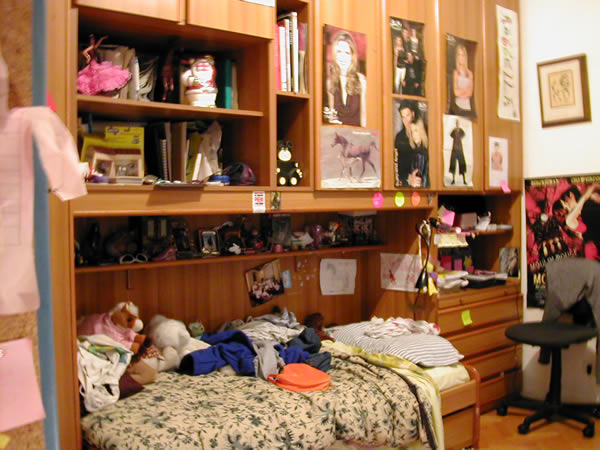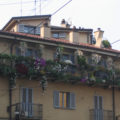^ top cameretta a ponte in Ross’ room in Milan. Where the chair is at right, a desktop slides out, though Ross never used it that way. (This fuzzygraph is Ross’ early work when we got our first digital camera.)
Living space is tight in Italian cities, which are often geographically constrained because built into, on top of, or between mountains – the kind of urban sprawl you see in America simply can’t occur in most parts of Italy.
Even where there is room to spread out, historically Italians tended not to. This may be due to centuries of history: until recently, Italy was a collection of separate city-states which were often at war with their neighbors; people huddled into fortress towns and cities for safety, and many Italians have never lost this preference for living close together.
Urban Italians have been living in apartments, condos, and townhouses since Roman times. The apartment building was invented in ancient Rome, and even in those days single-family dwellings were only for very rich families. Italian cities today are almost entirely apartment buildings, four to five stories tall in mid-sized towns, eight to ten in larger cities. In many buildings, the lowest floor sare reserved for commercial use. Where we lived in Milan, we had a greengrocer, bar/gelateria, baker, and butcher right downstairs – extremely convenient, since I was always forgetting something in my shopping.
The primo piano (first floor above ground level) is undesirable to live on, partly because of pollution, partly because it’s more vulnerable to housebreaking (that’s why you often see bars on the lower windows of older buildings); first floor apartments are often used as offices.
The higher up you go, the higher the value of the real estate, because the higher floors get more light and air and less pollution, and are less susceptible to being robbed. But the floor space remains the same – usually small. So how do you fit, say, three people, with all their possessions, into 70 square meters (~750 square feet)?
One way is to go vertical. Ceilings in Italy are higher than the American average, (although they’ve gotten lower in modern buildings). You build your bookcases go all the way to the ceiling. Closets are divided vertically into two sections: use the top sections for out-of-season clothing, lifting the clothes on hangers up to the high rod with a long-handled hook.
In some old buildings, the ceilings are so high that apartment owners are able to build in a loft. If you don’t want to go to that much trouble or expense, you can buy a loft bed from Ikea, which leaves a nice workspace underneath. I’ve been tempted by those, but I’m scared of heights, I get up a lot at night, and getting sheets onto such a bed looks like a hassle.
Bunkbeds and loft beds are quite common for kids’ rooms, often built into closet/desk/bed units called camerette (little rooms). A cameretta a ponte (“with a bridge”) has part of the closet built over the bed. There are entire furniture stores devoted to camerette in every conceivable style, some of them the kind of fun furniture kids dream about, with playspace under the bed, a miniature staircase going up to a loft bed (the steps lift up to provide storage space) and/or a slide for disembunking.





